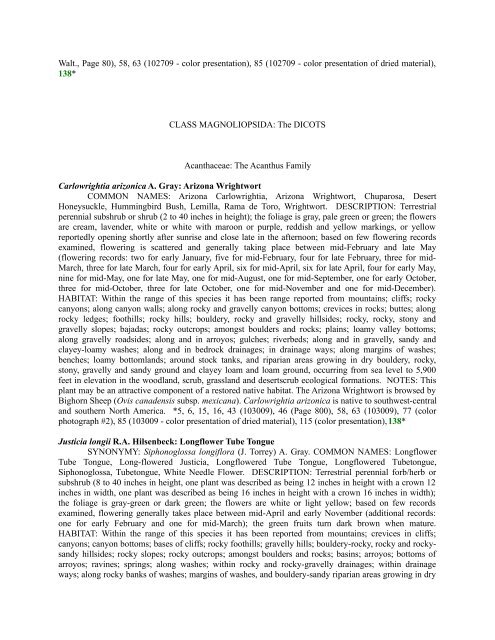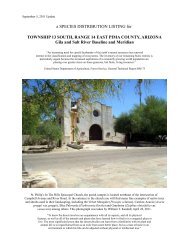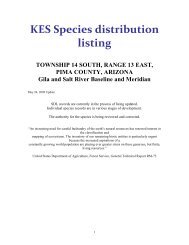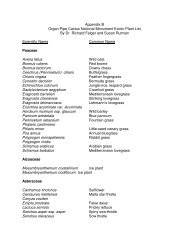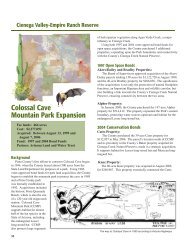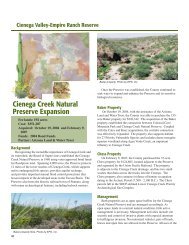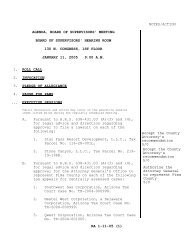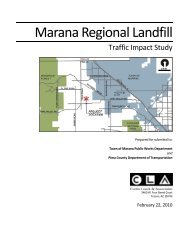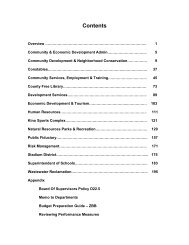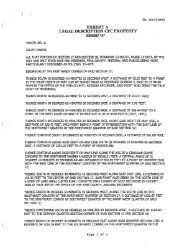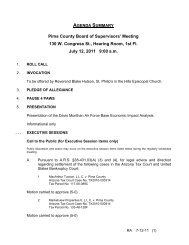Le Jardin de Mère Nature dans une Petite Planète - Pima County
Le Jardin de Mère Nature dans une Petite Planète - Pima County
Le Jardin de Mère Nature dans une Petite Planète - Pima County
You also want an ePaper? Increase the reach of your titles
YUMPU automatically turns print PDFs into web optimized ePapers that Google loves.
Walt., Page 80), 58, 63 (102709 - color presentation), 85 (102709 - color presentation of dried material),<br />
138*<br />
CLASS MAGNOLIOPSIDA: The DICOTS<br />
Acanthaceae: The Acanthus Family<br />
Carlowrightia arizonica A. Gray: Arizona Wrightwort<br />
COMMON NAMES: Arizona Carlowrightia, Arizona Wrightwort, Chuparosa, Desert<br />
Honeysuckle, Hummingbird Bush, <strong>Le</strong>milla, Rama <strong>de</strong> Toro, Wrightwort. DESCRIPTION: Terrestrial<br />
perennial subshrub or shrub (2 to 40 inches in height); the foliage is gray, pale green or green; the flowers<br />
are cream, laven<strong>de</strong>r, white or white with maroon or purple, reddish and yellow markings, or yellow<br />
reportedly opening shortly after sunrise and close late in the afternoon; based on few flowering records<br />
examined, flowering is scattered and generally taking place between mid-February and late May<br />
(flowering records: two for early January, five for mid-February, four for late February, three for mid-<br />
March, three for late March, four for early April, six for mid-April, six for late April, four for early May,<br />
nine for mid-May, one for late May, one for mid-August, one for mid-September, one for early October,<br />
three for mid-October, three for late October, one for mid-November and one for mid-December).<br />
HABITAT: Within the range of this species it has been range reported from mountains; cliffs; rocky<br />
canyons; along canyon walls; along rocky and gravelly canyon bottoms; crevices in rocks; buttes; along<br />
rocky ledges; foothills; rocky hills; boul<strong>de</strong>ry, rocky and gravelly hillsi<strong>de</strong>s; rocky, rocky, stony and<br />
gravelly slopes; bajadas; rocky outcrops; amongst boul<strong>de</strong>rs and rocks; plains; loamy valley bottoms;<br />
along gravelly roadsi<strong>de</strong>s; along and in arroyos; gulches; riverbeds; along and in gravelly, sandy and<br />
clayey-loamy washes; along and in bedrock drainages; in drainage ways; along margins of washes;<br />
benches; loamy bottomlands; around stock tanks, and riparian areas growing in dry boul<strong>de</strong>ry, rocky,<br />
stony, gravelly and sandy ground and clayey loam and loam ground, occurring from sea level to 5,900<br />
feet in elevation in the woodland, scrub, grassland and <strong>de</strong>sertscrub ecological formations. NOTES: This<br />
plant may be an attractive component of a restored native habitat. The Arizona Wrightwort is browsed by<br />
Bighorn Sheep (Ovis cana<strong>de</strong>nsis subsp. mexicana). Carlowrightia arizonica is native to southwest-central<br />
and southern North America. *5, 6, 15, 16, 43 (103009), 46 (Page 800), 58, 63 (103009), 77 (color<br />
photograph #2), 85 (103009 - color presentation of dried material), 115 (color presentation), 138*<br />
Justicia longii R.A. Hilsenbeck: Longflower Tube Tongue<br />
SYNONYMY: Siphonoglossa longiflora (J. Torrey) A. Gray. COMMON NAMES: Longflower<br />
Tube Tongue, Long-flowered Justicia, Longflowered Tube Tongue, Longflowered Tubetongue,<br />
Siphonoglossa, Tubetongue, White Needle Flower. DESCRIPTION: Terrestrial perennial forb/herb or<br />
subshrub (8 to 40 inches in height, one plant was <strong>de</strong>scribed as being 12 inches in height with a crown 12<br />
inches in width, one plant was <strong>de</strong>scribed as being 16 inches in height with a crown 16 inches in width);<br />
the foliage is gray-green or dark green; the flowers are white or light yellow; based on few records<br />
examined, flowering generally takes place between mid-April and early November (additional records:<br />
one for early February and one for mid-March); the green fruits turn dark brown when mature.<br />
HABITAT: Within the range of this species it has been reported from mountains; crevices in cliffs;<br />
canyons; canyon bottoms; bases of cliffs; rocky foothills; gravelly hills; boul<strong>de</strong>ry-rocky, rocky and rockysandy<br />
hillsi<strong>de</strong>s; rocky slopes; rocky outcrops; amongst boul<strong>de</strong>rs and rocks; basins; arroyos; bottoms of<br />
arroyos; ravines; springs; along washes; within rocky and rocky-gravelly drainages; within drainage<br />
ways; along rocky banks of washes; margins of washes, and boul<strong>de</strong>ry-sandy riparian areas growing in dry


